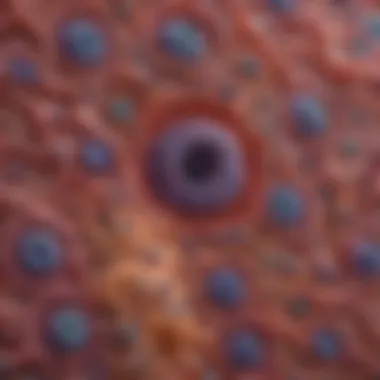Atypical Cells Treatment: Approaches and Implications


Intro
Atypical cells are abnormal cells that can indicate pre-cancerous or cancerous changes in the body. Their presence warrants thorough examination and timely intervention. Understanding the approach to treatment is crucial for medical professionals, researchers, and patients alike. With advancements in medical technology, the options for managing atypical cells have evolved significantly, leading to improved patient outcomes.
In the realm of oncology, the implications of atypical cells extend well beyond mere detection. They point towards the necessity for early diagnosis and tailored treatment strategies. This article aims to delve into the various treatment modalities, highlight research advancements, and explore the factors influencing patient care.
Research Overview
Understanding the behaviors and characteristics of atypical cells is paramount in the fight against cancer. Ongoing research has unveiled critical insights into these cells.
Summary of Key Findings
Recent studies showcase:
- Diverse behavior: Atypical cells may exhibit different characteristics, influencing treatment choices.
- Biomarker development: Some atypical cells serve as biomarkers for specific cancer types, enhancing diagnostic precision.
- Emerging treatments: Advancements in immunotherapy and targeted therapies provide more effective options for patients.
Importance of the Research
The significance of researching atypical cells lies in:
- Early intervention: Identifying atypical cells enables timely treatment, which is vital in improving prognosis.
- Personalized treatment: Understanding the cellular behavior can lead to tailored therapies, promoting better outcomes for diverse patient populations.
- Enhancing clinical guidelines: Continuous research helps refine existing treatment protocols, ensuring healthcare providers are equipped with the latest knowledge.
Treatment Modalities
The management of atypical cells often involves a multifaceted approach, combining various treatment modalities. Surgical, radiological, and pharmacological interventions play critical roles.
Surgical Interventions
In cases where atypical cells are localized, surgical removal may be warranted. This approach can prevent progression to cancer, especially in early detection stages. However, surgery's applicability depends on the individual case.
Radiological Approaches
Radiation therapy can be applied when atypical cells show a propensity for growth or are exposed during screenings. This method targets abnormal cells while minimizing damage to surrounding healthy tissues. Various radiological techniques are utilized, including:
- External beam radiation: Delivers high-energy beams to the area where atypical cells are present.
- Brachytherapy: Involves placing radioactive material near or within the tumor.
Pharmacological Treatments
Drug therapies also constitute a vital element of treatment. The introduction of targeted therapy and immunotherapy has revolutionized how atypical cells are managed. This includes:
- Targeted therapies: Focus on specific molecular pathways associated with atypical cell growth.
- Immunotherapies: Enhance the immune system's ability to recognize and destroy abnormal cells.
Future Implications
The findings on atypical cells will continue to shape cancer treatment protocols. With each advancement in research, there is hope for more effective interventions. The integration of precision medicine could revolutionize patient care and enhance outcomes significantly.
"Understanding atypical cells is a critical key to unlocking targeted treatments and improving survival rates in oncology."
Prelude to Atypical Cells
Atypical cells serve as an essential focal point in the fields of medicine and oncology. Recognizing their significance aids in understanding potential abnormalities, which could lead to various diseases, including cancer. The examination of these cells can be critical for early detection and successful patient management.
Definition and Characteristics
Atypical cells are defined as cells that exhibit abnormal growth and structure. They diverge from normal cell morphology and can indicate underlying pathological processes. Common characteristics include irregular shapes, enlarged nuclei, and variations in cell size and shape. These features can be observed through histopathological examinations, highlighting their relevance in diagnostic practices.
Understanding the characteristics of atypical cells helps clinicians assess the risk of malignancy.
Such distinctions are vital; while some atypical cells may be benign, others can signify more serious conditions. For instance, cervical atypical cells can appear in Pap smear results, necessitating further investigation or intervention. Awareness of these characteristics is crucial for healthcare professionals.
Etiology of Atypical Cells
The etiology of atypical cells spans various factors, including genetic, environmental, and lifestyle influences. Many conditions can contribute to the formation of atypical cells, such as exposure to carcinogens, viral infections, and chronic inflammation.
- Genetic factors: Mutations in certain genes can predispose cells to atypical changes. These mutations can lead to uncontrolled cell division.
- Environmental factors: Prolonged exposure to harmful substances like tobacco smoke, chemicals, or radiation can trigger atypical cell development.
- Infections: Some viral infections, such as human papillomavirus (HPV), are known to cause atypical arrangements in cervical cells.
Understanding these underlying causes is fundamental, as it aids in developing preventive strategies and treatment protocols. The ability to recognize the importance of these factors can enhance educators' and researchers' discussions about relating to cell abnormalities.
Ultimately, a thorough understanding of atypical cells lays a framework for significant discussions in diagnosis, treatment, and research.
Classifications of Atypical Cells
Understanding the classifications of atypical cells is crucial for medical professionals, researchers, and educators as it provides a framework for interpreting diagnoses, treatment strategies, and patient outcomes. Classifications help in assessing the nature of the atypical cells, determining whether they are benign or malignant. Moreover, it enables clinicians to devise appropriate therapeutic interventions and anticipate the prognosis for patients.


Benign vs. Malignant Atypical Cells
Atypical cells can be categorized into two main types: benign and malignant.
Benign atypical cells indicate non-cancerous changes. They may appear unusual in structure under the microscope, but they do not invade surrounding tissues or spread to other parts of the body. For instance, cells from conditions like cervical dysplasia or fibromas show atypical characteristics but are generally not life-threatening. Treatments might involve monitoring or minor surgical procedures to remove lesions.
In contrast, malignant atypical cells signify a more serious condition. These cells have cancerous characteristics, capable of invading neighboring tissues and metastasizing. Early detection is key in these cases, as timely intervention can significantly improve patient survival rates. For example, atypical cells detected in a biopsy of breast tissue might warrant aggressive treatments such as chemotherapy or mastectomy, depending on factors like stage and grade.
"The distinction between benign and malignant atypical cells is often the first step in determining treatment and management strategies."
Grading and Staging
Grading and staging are essential for understanding the behavior of atypical cells. Grading refers to how abnormal the cells look under a microscope. High-grade atypical cells tend to look more abnormal and are likely to behave aggressively. On the other hand, low-grade atypical cells are more similar to normal cells and typically indicate a slower growth rate.
Staging assesses the extent of the cancer in the body and helps to determine the appropriate treatment path. The most common system used is the TNM system, which considers:
- T (Tumor Size): How large is the primary tumor?
- N (Node Involvement): Are lymph nodes affected?
- M (Metastasis): Has the cancer spread?
Both grading and staging are not only pivotal for crafting a treatment plan, they also play a significant role in predicting outcomes. For example, a patient with low-grade, localized breast carcinoma may have a better prognosis compared to a patient with high-grade, metastatic breast carcinoma.
In summary, the classification of atypical cells, along with their grading and staging, offers vital insights for managing treatment approaches and understanding implications for patient care. This systematic analysis allows for personalized treatment plans that consider individual patient conditions, improving overall care and outcomes.
Diagnostic Approaches
Understanding the diagnostic approaches for atypical cells is crucial within the context of this article. These methods not only assist in identifying the potential presence of abnormalities but also play an essential role in determining the most effective treatment strategies. Diagnostic accuracy can significantly influence patient outcomes. By utilizing a combination of techniques, healthcare professionals can formulate a comprehensive view of the patient's condition, thereby enabling informed decision-making regarding the management of atypical cells.
Histopathological Examination
Histopathological examination is a cornerstone in the diagnosis of atypical cells. This process involves the microscopic analysis of tissue samples obtained through biopsy or surgical resection. The examination provides critical insights into the cellular architecture, identifying specific features that signal atypical behavior.
The key characteristic of histopathology is its ability to differentiate between benign and malignant cells. This diagnostic tool allows pathologists to observe changes in cell size, shape, and organization, which can indicate underlying malignancy. The results of histopathological evaluations guide treatment options, laying a foundation for subsequent interventions. However, it is important to recognize that histopathological analysis might require a highly skilled specialist to ensure accuracy and minimize misdiagnosis, which can impact treatment outcomes negatively.
Imaging Techniques
Imaging techniques are essential for the thorough evaluation of atypical cells. They provide a non-invasive means of assessing lesions and understanding their extent and localization. Three primary imaging methods are commonly used: ultrasound, CT scan, and MRI.
Ultrasound
Ultrasound is notable for its real-time imaging capabilities and the absence of ionizing radiation. This technique is particularly useful for evaluating soft tissues and detecting abnormalities in various organs. The key characteristic of ultrasound is its ability to provide immediate visualization of structural anomalies. It is a beneficial choice for initial assessments of atypical cells, especially in the abdominal and pelvic regions.
One unique feature of ultrasound is its utility in guiding needle biopsies, allowing precise sampling of suspicious areas. However, it has limitations, such as operator dependency and challenges in imaging deeper structures due to sound wave absorption.
CT Scan
CT scans are integral in providing detailed cross-sectional images of the body. This method enhances the understanding of complex anatomical regions and enables the detection of small lesions often missed by other imaging modalities. The key characteristic of CT scans is their ability to visualize both soft tissue and bone. This versatility makes them a popular choice for comprehensive assessment.
CT imaging can also contribute significantly to staging cancer, as it can reveal metastases and lymph node involvement. However, one disadvantage is the exposure to ionizing radiation, which necessitates careful risk-benefit consideration in young patients or those requiring multiple imaging studies.
MRI
MRI is characterized by its exceptional soft tissue contrast and is particularly valuable in the assessment of brain and spinal abnormalities. The absence of radiation exposure is another compelling attribute, making it a safe alternative for repeated imaging.
One unique feature of MRI is the use of functional imaging techniques, which can assess metabolic activity in tissues. This can be essential when determining the aggressiveness of atypical cells. Nevertheless, MRI tends to be less accessible than other imaging modalities, and its lengthy scanning time may present challenges in certain clinical settings.
Imaging techniques are indispensable in the management of atypical cells, offering a non-invasive approach that enhances diagnostic precision.
Employing a combination of these diagnostic approaches contributes to a nuanced understanding of atypical cells, facilitating proper treatment planning tailored to each patient's unique situation.
Treatment Modalities for Atypical Cells
Treatment modalities for atypical cells are an integral part of understanding and managing potential malignancies. These modalities are crucial in establishing how atypical cells are addressed after diagnosis. Each treatment approach varies in its implementation and implications.
One key advantage of diverse treatment options is that they allow healthcare providers to tailor approaches based on individual patient needs. Atypical cells can indicate a range of conditions, necessitating careful deliberation on the best course of action.
The importance of efficacy and safety cannot be overstated. Choices made in treatment modalities can significantly impact patient outcomes. Therefore, it is essential to explore various methods systematically, recognizing their benefits, risks, and contribution to overall patient care.
Surgical Interventions
Surgical interventions form a primary approach in the treatment of atypical cells. They involve the physical removal of abnormal tissues, which can help in reducing the risk of progression to cancer. Surgical options can range from minimally invasive techniques to extensive resections, depending on the type and location of the atypical cells.
Types of Surgical Procedures
Types of surgical procedures are diverse. These include excisional biopsies, where the abnormal cells are removed entirely, and more complex operations such as lobectomies or bilobectomies, which involve removing sections of organs like the lung or breast.


One key characteristic of these procedures is their ability to provide a definitive diagnosis through pathology reports on the excised material. This can lead to better-informed decisions regarding further therapeutic steps. The primary advantage of surgical intervention is that it can potentially eradicate the abnormality completely.
However, these procedures are not without drawbacks—risks of infection and complications related to anesthesia must be considered. Collaborative discussions between patients and healthcare providers are vital in weighing benefits against these risks.
Considerations and Risks
Considerations and risks of surgical interventions encompass a broad range of factors. One critical aspect is the patient's overall health status, which can influence surgical outcomes. Patient age, comorbidities, and previous surgical history can all affect the decision-making process.
Another important characteristic is the location of the atypical cells; different organs present different challenges during surgical procedures. It’s important to evaluate these nuances thoroughly. Patients must understand what to expect, including recovery times and potential for recurrence.
The unique feature of surgical risks is their variability; each patient may respond differently to surgery. Factors like healing ability and subsequent care can impact overall treatment success. Despite the risks, surgical options remain a valuable choice in managing atypical cells.
Radiation Therapy
Radiation therapy serves as a critical method in treating atypical cells, particularly when surgery is not an option or when there's a necessity for adjunctive therapy post-operation. It uses high-energy rays to target and kill cancerous cells. This approach is especially beneficial in zones where surgical excision is complicated due to location or other health factors.
Radiation therapy can also reduce the size of tumors before surgical intervention, facilitating easier removal. One major consideration is the potential side effects, such as fatigue and skin irritation, which need to be monitored and managed effectively.
Chemotherapy and Drug Therapy
Chemotherapy and drug therapy stand as pivotal players in the management of atypical cells, especially when they display malignant tendencies. This treatment involves using specific medications to destroy cancer cells or prevent their growth. Multiple agents may be combined to enhance effectiveness and reduce the risk of resistance.
Targeted Therapy
Targeted therapy focuses on specific characteristics of cancer cells. This approach disrupts the growth and spread of these cells while sparing normal cells, making it a less toxic option compared to traditional chemotherapy. It can be a beneficial choice due to its precision in targeting malignant cells.
However, targeted therapy may not be suitable for all patients, and its effectiveness depends on the presence of specific biomarkers. Regular assessments are necessary to ensure that treatment remains aligned with the disease's status.
Immunotherapy
Immunotherapy takes advantage of the body’s immune system to combat atypical cells. This approach is gaining interest due to its potential to provide longer-lasting remission compared to other treatments. It can stimulate the immune response against cancerous cells, contributing significantly to a patient’s overall strategy in managing atypical cells.
The unique feature of immunotherapy is its ability to learn and adapt as it recognizes cancerous cells, which can contribute to a personalized treatment plan. One downside includes the possibility of immune-related side effects, which require careful monitoring.
The continued exploration of these treatment modalities is essential in optimizing patient outcomes and understanding how to best manage atypical cells.
Emerging Treatment Strategies
Emerging treatment strategies play a crucial role in the ongoing evolution of medical care for atypical cells. These innovative approaches not only hold potential for improving patient outcomes but also expand the understanding of cellular behavior and treatments in oncology. Atypical cells may indicate the presence of abnormal growth, which could escalate into cancer. Therefore, new methodologies that target these cells are paramount.
Advancements in genetic and cellular therapies have opened pathways for more precise treatments. These strategies often result in less invasive procedures and improved efficacy in targeting cancer cells without affecting surrounding healthy tissue. Additionally, emerging technologies can facilitate personalized medicine, tailoring treatments based on an individual’s specific cellular profile. This promises higher success rates and can mitigate many adverse reactions associated with traditional treatments.
Gene Therapy Approaches
Gene therapy approaches represent one of the most promising areas in treating atypical cells. This innovative technique involves modifying the genes within a patient’s cells to prevent or treat disease. By targeting the genetic mutations that lead to the formation of atypical cells, researchers aim to restore normal cell function or induce apoptosis in malignant cells.
Recent studies illustrate the potential of CRISPR-Cas9 technology in this context. By enabling precise edits to the genome, researchers can potentially eliminate the faulty genes that contribute to atypical cell behavior. The significance of these methods lies in their specific targeting, which minimizes damage to surrounding healthy cells. For example, the use of viral vectors to deliver corrected genes has shown efficacy in clinical trials focused on certain cancers. However, while gene therapy demonstrates great promise, challenges such as delivery mechanisms and immune response remain as ongoing areas of research.
Stem Cell Research and Potential
Stem cell research holds exceptional potential for addressing atypical cells. The ability of stem cells to differentiate into various cell types offers a unique platform for understanding and treating various cellular abnormalities, including those leading to cancer. Researchers investigate how stem cells can be used not just to replace damaged tissues but also as a means of regenerative therapy.
The application of stem cells in treating atypical cells includes developing personalized treatments tailored to the patient’s own stem cells. This reduces the risk of rejection and enhances treatment effectiveness. Furthermore, research into induced pluripotent stem cells (iPSCs) has shown that these cells can be reprogrammed to an embryonic-like state, allowing them to become any cell type. This ability creates a potential avenue for regenerative medicine.
However, the challenges in stem cell research are significant. Ethical considerations about stem cell sourcing, as well as regulatory hurdles in clinical applications, continue to influence this field. Ongoing clinical trials are critical to uncovering the full scope of their potential in oncology.
"Emerging treatment strategies provide an opportunity to not just treat but potentially cure atypical cell pathology, marking a shift in the treatment paradigm."
These strategies highlight a shift towards personalized and more effective therapies, crucial for managing atypical cells and improving the overall prognosis. Further exploration in this area holds the potential to reshape the future landscape of cancer treatment and management.
The Role of Early Detection
Early detection of atypical cells is an essential component in the strategy for managing potential cancerous conditions. Identifying these cells at an initial stage greatly influences treatment outcomes. When atypical cells are detected earlier, there are often more treatment options available. Cancer treatment tends to be most effective when initiated before progression to advanced stages. This proactive approach not only enhances patient prognosis but also aids in reducing mortality rates associated with various cancers.
Importance in Patient Prognosis
The prognostic implications of early detection are profound. Studies suggest that patients diagnosed at an early stage of atypical cells have a significantly higher survival rate compared to those diagnosed later. Therefore, identifying atypical cells promptly allows for timely intervention.
- Early detection fosters better treatment responses. Patients can receive less aggressive treatments, which may spare healthy tissues and reduce side effects.
- It provides opportunities for monitoring and surveillance. Frequent assessments help in tracking disease progression effectively.
- The psychological impact is also noteworthy. Patients often feel a greater sense of control when their healthcare teams manage their condition proactively, which can improve overall well-being.
"The key to better outcomes lies within the timely identification of atypical cells, enabling effective treatment decisions and enhanced patient confidence."
Screening Programs and Guidelines


Screening for atypical cells focuses on minimizing late-stage diagnoses. Various screening programs aim to facilitate early detection. These programs vary based on cancer types and involve different methodologies. It is crucial to adhere to established guidelines to make screening successful.
Some common screening methods include:
- Pap Smear: Primarily for cervical cancer; it allows for early identification of atypical cells in cervical tissue.
- Mammography: Used for breast cancer detection, this imaging technique can uncover atypical cells before symptoms arise.
- Colonoscopy: This method screens for colorectal cancers and can identify atypical cells in the colon.
Guidelines from organizations like the American Cancer Society emphasize regular screenings. These guidelines recommend starting screenings based on factors such as age, genetics, and family history. By following these protocols, healthcare professionals enhance the likelihood of detecting atypical cells earlier, thus contributing to improved patient outcomes.
Engaging in education about screening benefits can also encourage patients to participate actively in their health management. By prioritizing early detection, the medical community lays groundwork for effective interventions and better health strategies.
Patient Management and Follow-Up Care
Managing patients with atypical cells is crucial for optimizing treatment outcomes. This phase includes both immediate support and long-term strategies aimed at enhancing the quality of life. Effective management can significantly influence the patient’s prognosis and overall well-being. It involves continuous assessment, tailored interventions, and building a support structure around the patient.
Psychosocial Support for Patients
Psychosocial support is an essential component of patient management. Individuals diagnosed with atypical cells often experience emotional distress, anxiety, and uncertainty about their health. Providing support can involve counseling services, support groups, and educational resources. This integration can help patients cope with their diagnosis and treatment.
- Counseling Services: Professional counseling offers a safe space for patients to express their feelings. Specialists can provide coping strategies and emotional guidance.
- Support Groups: Involvement in group sessions helps patients share experiences and reduce feelings of isolation. It fosters a sense of community and shared understanding.
- Educational Resources: Knowledge about their condition empowers patients. Informative seminars and materials can clarify uncertainties surrounding treatment options and outcomes.
Building a support framework allows patients to navigate their path with greater confidence and resilience.
Long-term Monitoring Strategies
Long-term monitoring is critical for patients with atypical cells. Regular follow-ups allow for timely detection of any changes in their condition. These strategies may include:
- Routine Imaging: Conducting imaging tests, like CT scans or MRIs, helps assess any potential abnormalities. Regular intervals for these tests ensure early intervention if necessary.
- Blood Tests: Periodic blood tests can provide valuable insights into the patient's health status. Monitoring specific markers can indicate the presence of any underlying issues.
- Clinical Assessments: Scheduled visits with medical professionals allow for comprehensive evaluations. These assessments can include physical examinations, screenings, and consultations with specialists.
Regular monitoring plays a vital role in ensuring that patients remain informed about their health, thus enabling proactive decision-making in their treatment journey.
Case Studies and Research Findings
The exploration of atypical cells and their treatment is enriched through case studies and research findings. These elements provide essential insights into therapeutic efficacy, patient outcomes, and the overall practicality of different treatment approaches. Case studies allow clinicians and researchers to observe real-world applications of theoretical knowledge. They illustrate the variety of presentations that atypical cells may exhibit and the diverse response of patients to different interventions.
A primary benefit of case studies is their ability to highlight individual patient experiences. They expose variations in how atypical cells might behave in different biological contexts or demographics. This contributes critically to the understanding of treatment effectiveness, which can significantly vary based on factors such as age, sex, underlying health conditions, and more. The sharing of such findings fosters a deeper comprehension of how best to tailor treatment plans for patients, thus improving care.
Moreover, case studies often serve as a foundation for further research. They can reveal gaps in existing knowledge and suggest areas for future inquiry. Such findings can be pivotal in shaping hypotheses for larger-scale clinical trials, aiming to validate or refute observed phenomena in a controlled environment.
In essence, the role of case studies and research findings is invaluable. They not only guide clinical practices but also inform future investigations that strive to enhance the understanding of atypical cells and their management.
Notable Studies in Atypical Cell Treatment
Significant studies in the field of atypical cell treatment have provided key findings that influence current medical practices. Research has focused on various treatment modalities, exploring their effectiveness and safety for patients with atypical cells. The results from these studies offer critical insights that can guide future treatment protocols. Some notable findings include:
- Studies indicating that early intervention can improve outcomes for patients with atypical cells, particularly when combined with multidisciplinary approaches.
- Research demonstrating that certain targeted therapies, such as those involving Nivolumab, have shown promise in treating malignancies associated with atypical cell changes, enhancing survival rates in some patient populations.
A thorough examination of such studies reveals the ongoing evolution of treatment methodologies. As researchers continue to refine their techniques and expand their knowledge, the implications for clinical practice become more robust.
Lessons from Clinical Trials
Clinical trials offer structured environments to evaluate the safety and efficacy of new therapies for atypical cell conditions. They provide lessons that extend beyond the immediate findings. Here are some pivotal insights derived from clinical trials:
- Importance of Patient Selection: Assessing eligibility based on specific biological markers can dramatically influence trial outcomes. This emphasizes the need for personalized approaches in treatments.
- Efficacy of Combination Therapies: Trials have frequently demonstrated that combining therapies, such as chemotherapy with targeted therapy, often yields better outcomes compared to monotherapy.
- Monitoring Adverse Effects: Comprehensive tracking of side effects in clinical trials informs safer treatment protocols and better management strategies for patients in real-world settings.
Overall, the lessons learned from clinical trials are crucial for informing best practices and eventually improving patient care. They create a framework through which new treatment protocols can be designed, tested, and refined continuously, reflecting the dynamic nature of medical research in the realm of atypical cell treatment.
"The convergence of clinical insights and research findings is essential for the progress of atypical cell management practices."
Closure and Future Directions
In the multifaceted domain of treating atypical cells, understanding the current landscape is essential for shaping future strategies. The critical nature of this discussion emerges from the interplay between established treatments and developing methodologies that could redefine patient care. Grounded in ongoing research efforts, the future of atypical cell management holds promise for improved outcomes.
Summarizing Treatment Advances
Recent advances in treating atypical cells highlight several key developments. These encompass a wide spectrum of treatment approaches: surgical interventions remain a cornerstone for many, while radiation and chemotherapy are integral in tackling malignancies. Furthermore, emerging therapies, such as gene therapy and immunotherapy, present new avenues for targeted treatment, aiming to minimize side effects and enhance efficacy.
The rapid evolution of imaging technologies also plays a role in identifying atypical cells early on. Enhanced diagnostic tools allow for more precise characterization of cellular anomalies. This shift not only facilitates better-informed treatment paths but also supports ongoing surveillance for patients at risk.
The integration of interdisciplinary research positions atypical cell management at the forefront of personalized medicine.
In summary, the advances in treatment underscores the necessity for continual adaptation and learning within this field. Research into patient response is vital to optimize strategies further, and collaboration across disciplines can significantly impact treatment agendas.
The Future of Atypical Cell Management
Looking toward the future, the management of atypical cells is set to evolve in several meaningful ways. Innovations in technology and pharmacology are likely to lead to the development of more tailored treatment protocols. The emergence of artificial intelligence in diagnostic practices promises to enhance predictive accuracy and tailor interventions.
As research expands, so will the understanding of the genetic and molecular profiles of atypical cells. This deeper comprehension could enable the identification of novel biomarkers, helping clinicians determine the most effective treatment options.
Additionally, public health initiatives focusing on education and awareness about atypical cells can foster early detection strategies. Enhanced screening programs can ultimately lead to timely interventions and better patient prognoses.



